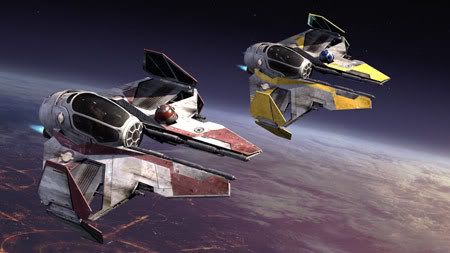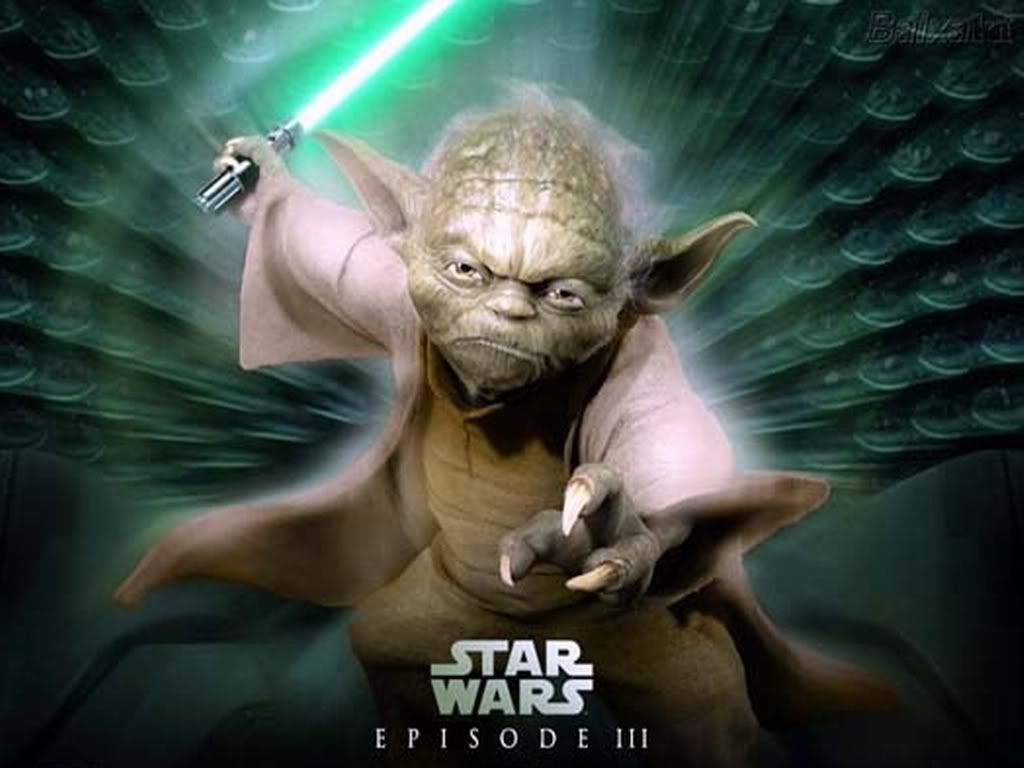Post by Rose on Apr 24, 2007 1:22:54 GMT -5
Jedi Starfighter


Basic Information -
Size: (Delta-7) 8 meters long; (Eta-2) 5.47 meters long
Manufacturer: Kuat Systems Engineering
Type: Light Interceptor Starfighter
Weapon: (Delta-7) Laser Cannons; (Eta-2) Dual Laser Cannons; 2 Secondary Ion Cannons
Affiliation: Jedi
Associations: Gallia, Adi; Jedi Starfighter; Kenobi, Obi-Wan (Ben); R4-P17; Skywalker, Anakin; Tiin, Saesee
Small wedge-shaped one-man starfighters, these vessels were used by the Jedi order in the waning days of the Galactic Republic. While the ship does employ weapons, most Jedi pilots preferred to rely on their cunning and attunement to the Force to avoid disputes and aggression. A truncated astromech droid was hard-wired into the starfighter's port side, providing repair and navigation information to the Jedi pilot. The vessel was too small to carry a hyperdrive, and instead relied on a separate booster craft for transit through hyperspace. The Jedi Temple maintained a well-stocked hangar of Jedi starfighters within one of its many spires. A retractable landing pad slid forth from the tower, extending to its length to allow the fighter clearance from the Temple.
Obi-Wan Kenobi piloted a Jedi starfighter while investigating the Separatist-funded assassination attempts on Senator Padmé Amidala of Naboo. Equipped with a hyperdrive booster ring, Obi-Wan voyaged to the distant worlds of Kamino and Geonosis while searching for answers. With the outbreak of the Clone Wars, the Jedi saw themselves pressed into the forefront of military activity, serving as Generals in the campaign against the Separatists. The demands of combat saw advancements in the Jedi starfighter arsenal, resulting in modifications and a new generation of fighter craft. Though the wedge-shaped starfighter design was still in use by war's end, a newer model had earned the spotlight for its use by renowned Jedi heroes, Anakin Skywalker and Obi-Wan Kenobi.
This new model was much more compact, cutting away a large portion of the forward spaceframe to have a forked front, bracketing a bulbous cockpit pod. Lining the inner edges of the ship's "tines" were powerful long-barreled laser cannons. The ship also had secondary cannons recessed on the outer edge of each tine. A full-size astromech rested within a spring-loaded socket on the port wing, and the craft's wingtips could fold open, revealing hexagonal panels when the ship entered combat mode. The hexagonal wings and the spoke-windowed cockpit were strong indicators of future starfighter designs to be adopted by the galactic government. This new model also lacked a hyperdrive, so it too had to rely upon a hyperspace transport ring to achieve superluminal velocities. During the war, bigger more robust rings were used, with multiple lightspeed engines increasing their speed and range.

The finished model of the Jedi starfighter was unveiled just a few weeks prior to the outbreak of the Clone Wars. Project Engineer Walex Blissex led the crack team of engineers that developed the Delta-7 Aethersprite starfighter at the Kuat Systems Engineering Facilities. At a special ceremony at the Kuat Drive Yards, Kuati Senator Risi Lenoan and Jedi representatives Adi Gallia and Aayla Secura were on hand to officially launch the finished Delta-7 model. Earlier models were field-tested by Jedi Master Adi Gallia. Though the standard Delta-7 is too small to carry an onboard hyperdrive, and must instead rely on a TransGalMeg Industries booster ring, there does exist a small number of advanced models with an onboard experimental lightspeed engine.During the Clone Wars, ace Jedi pilots like Anakin Skywalker and Saesee Tiin pushed the Delta-7 to its limits. Skywalker constantly tinkered with his starfighter, modifying its systems to optimize performance.
Based on his innovations, Kuat Systems Engineering revisited the starfighter design and developed a bold and radical follow-up to the Delta-7 with its Eta-2 Actis interceptor. Anakin Skywalker was the first to pilot this new model, though other Jedi soon followed in his path, including Tiin, Obi-Wan Kenobi and Mace Windu. Only a Jedi pilot would be brave enough to fly an Eta-2 into combat. That's not to disparage its capabilities; rather, it is a very advanced high-performance craft that devotes most of its system resources to pure speed and power. It does so at the expense of heavy flight instruments, sensors and shields. A Jedi Knight's attunement to the Force more than compensates for these compromises. In compressing -- yet increasing -- the performance of the Delta-7 into a frame no bigger than an airspeeder, Kuat engineers faced many challenges. Key among them was overheating. A sophisticated system of pumps, heat sinks and extendable radiator wing panels help draw heat away from the Eta-2's miniature reactor.
